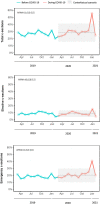Impact of the COVID-19 pandemic on perinatal care and outcomes: A retrospective study in a tertiary hospital in Northern Ghana
- PMID: 38820360
- PMCID: PMC11142585
- DOI: 10.1371/journal.pone.0301081
Impact of the COVID-19 pandemic on perinatal care and outcomes: A retrospective study in a tertiary hospital in Northern Ghana
Abstract
Background: Perinatal mortality remains a global challenge. This challenge may be worsened by the negative effects of the COVID-19 pandemic on maternal and child health.
Objectives: Examine the impact of the COVID-19 pandemic on perinatal care and outcomes in the Tamale Teaching Hospital in northern Ghana.
Methods: A hospital-based retrospective study was conducted in the Tamale Teaching Hospital. We compared antenatal care attendance, total deliveries, cesarean sections, and perinatal mortality before the COVID-19 pandemic (March 1, 2019 to February 28, 2020) and during the COVID-19 pandemic (March 1, 2020 to February 28, 2021). Interrupted time series analyses was performed to evaluate the impact of the COVID-19 pandemic on perinatal care and outcomes at TTH.
Results: A total number of 35,350 antenatal visits and 16,786 deliveries were registered at TTH from March 2019 to February 2021. Antenatal care, early neonatal death, and emergency cesarean section showed a rapid decline after the onset of the pandemic, with a progressive recovery over the following months. The total number of deliveries and fresh stillbirths showed a step change with a marked decrease during the pandemic, while the macerated stillbirths showed a pulse change, a temporary marked decrease with a quick recovery over time.
Conclusion: The COVID-19 pandemic had a negative impact on perinatal care and outcomes in our facility. Pregnancy monitoring through antenatal care should be encouraged and continued even as countries tackle the pandemic.
Copyright: © 2024 Abdul-Mumin et al. This is an open access article distributed under the terms of the Creative Commons Attribution License, which permits unrestricted use, distribution, and reproduction in any medium, provided the original author and source are credited.
Conflict of interest statement
The authors have declared that no competing interests exist.
Figures




Similar articles
-
Pregnancy outcomes before and during COVID-19 pandemic in Tamale Metropolis, Ghana: A retrospective cohort study.PLoS One. 2024 Apr 30;19(4):e0302589. doi: 10.1371/journal.pone.0302589. eCollection 2024. PLoS One. 2024. PMID: 38687775 Free PMC article.
-
Impact of the COVID-19 Pandemic on Excess Perinatal Mortality and Morbidity in Israel.Am J Perinatol. 2021 Mar;38(4):398-403. doi: 10.1055/s-0040-1721515. Epub 2020 Dec 10. Am J Perinatol. 2021. PMID: 33302306
-
Resilience and vulnerability of maternity services in Zimbabwe: a comparative analysis of the effect of Covid-19 and lockdown control measures on maternal and perinatal outcomes, a single-centre cross-sectional study at Mpilo Central Hospital.BMC Pregnancy Childbirth. 2021 Jun 4;21(1):416. doi: 10.1186/s12884-021-03884-5. BMC Pregnancy Childbirth. 2021. PMID: 34088285 Free PMC article.
-
Pregnancy outcome in unbooked mothers at a tertiary health institution, South-South, Nigeria.Niger J Med. 2016 Jul-Sep;25(3):294-300. Niger J Med. 2016. PMID: 30011174
-
Health system and community level interventions for improving antenatal care coverage and health outcomes.Cochrane Database Syst Rev. 2015 Dec 1;2015(12):CD010994. doi: 10.1002/14651858.CD010994.pub2. Cochrane Database Syst Rev. 2015. PMID: 26621223 Free PMC article. Review.
References
-
- Oestergaard MZ, Inoue M, Yoshida S, Mahanani WR, Gore FM, Cousens S, et al.. Neonatal mortality levels for 193 countries in 2009 with trends since 1990: a systematic analysis of progress, projections, and priorities. PLoS medicine. 2011;8(8):e1001080. Epub 20110830. doi: 10.1371/journal.pmed.1001080 ; PubMed Central PMCID: PMC3168874. - DOI - PMC - PubMed
MeSH terms
Grants and funding
LinkOut - more resources
Full Text Sources
Medical

